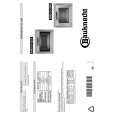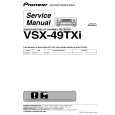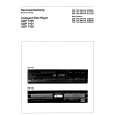No hay comentarios de productos.
TX-NR702,602_En.book Page 71 Tuesday, September 7, 2004 1:18 PM
Advanced Setup�Continued
4-1. Mono
â� a. Output Channel This setting determines which speakers are used to output mono audio when the Mono listening mode is used. L/R: Mono audio is output from the front left and right speakers (default). Center: Mono audio is output from the center speaker. â� b. Academy (TX-SR702/702E only) Early movies had a mono soundtrack that suffered from audible hiss and a poor high-frequency response due to the quality of the ï¬�lm. To improve matters, the high-frequencies were boosted before being recorded onto ï¬�lm, and then attenuated to their original levels during playback in the movie theater. Some old movies have been transferred to newer distribution media without the high frequencies being attenuated, creating a harsh sound with pronounced hiss. With the Academy Filter, which is based on the playback techniques used in those days, you can attenuate those high-frequencies to their original levels and enjoy the movie as it was intended to be heard. On: Academy Filter on. Off: Academy Filter off (default). of the center channel sound. It can be adjusted from 0 to 7 (default is 3). â� d. Center Image The DTS Neo:6 Music listening mode creates 6-channel surround sound from 2-channel (stereo) sources. With this setting, you can specify by how much the front left and right channel output is attenuated in order to create the center channel. It can be adjusted from 0 to 5 (default is 3). When set to 0, the front left and right channel output is attenuated by half (â��6 dB), giving the impression that the sound is located centrally. This setting works well when the listening position is considerably off center. When set to 5, the front left and right channels are not attenuated, maintaining the original stereo balance.
4-3. Enhance, 4-4. Orchestra, 4-5. Unplugged, 4-6. Studio-Mix, 4-7. TV Logic & 4-8. Mono Movie
These settings apply to the Onkyo original DSP listening modes. â� a. Front Effect With this setting, you can turn off the reverb for the front speakers. This is useful when playing live material that already contains live reverberation and the reverb added by the DSP listening mode simply blurs the original sound. When the Front Effect is turned off, no reverb is added to the front left, right, and center speakers and the original reverberation can be heard as it is. On: Front Effect on (default). Off: Front Effect off. â� b. Reverb Level With this setting, you can adjust the amount of reverb to suit your listening environment, source material, and so on. The available settings are: Low, Middle (default), and High. â� c. Reverb Time With this setting, you can adjust the reverb time to suit your listening environment, source material, and so on. The available settings are: Short, Middle (default), and Long.
4-2. PLIIx/Neo:6
If no surround back speakers are connected, this item will be â��PLII/Neo:6â�� instead of â��PLIIx/Neo:6.â�� â� a. Panorama With this function, you can broaden the width of the front stereo image when using the Dolby Pro Logic IIx Music listening mode. On: Panorama function on. Off: Panorama function off (default). â� b. Dimension With this setting, you can move the sound ï¬�eld forward or backward when using the Dolby Pro Logic IIx Music listening mode. The default setting is 3. Higher settings move the sound ï¬�eld forward. Lower settings move it backward. If the stereo image feels too wide, or thereâ��s too much surround sound, move the sound ï¬�eld forward to improve the balance. Conversely, if the stereo image feels like itâ��s in mono, or thereâ��s not enough surround sound, move it backward. â� c. Center Width With this function, you can adjust the width of the sound from the center speaker when using the Dolby Pro Logic IIx Music listening mode. If youâ��re using a center speaker, with Dolby Pro Logic IIx, the center channel sound is output by only the center speaker. (If youâ��re not using a center speaker, the center channel sound will be distributed to the front left and right speakers to create a phantom center). This setting controls the front left, right, and center mix, allowing you to adjust the weight
71





